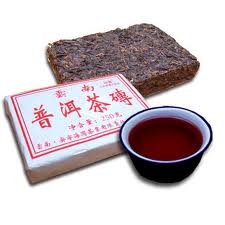Dim Sum and the fat-busting tea that was once banned from the US
Most teas have a shelf life. Green tea, if it’s too old, can tastes stale, flavorless, and lose color. Black tea can taste flat and off when past its prime. Then there’s Pu-erh, a tea that can take decades to mature, was once banned from the US (and was smuggled in) and now is touted as a drink to help lose weight, reduce cholesterol and shrink tumors.
No less an authority than Dr. Oz noted in a February 2012 episode of his show that that drinking two cups in the morning will help shrink fat cells. Another study from China identified statin,a class of cholesterol lowering drugs, in a Pu-erh extract of tea 20 to 25 years old. The tea has also been cited as an agent to reduce tumors: In a 2011 study published in the International Journal of Molecular Sciences, researchers found that, pu-erh inhibited tumor cell growth in mice cells.
“My grandmother used to drink pu-erh with dim sum,” says Vanessa C, a N.Y. attorney. Dim sum, also known as “little bits of heart” are the tapas of Asian cuisine: little bites that are steamed, pan fried, deep fried, or baked.They can also pile on calories. Depending on the chef, dim sum can be as simple as steamed shrimp dumplings or as sophisticated as “goldfish dumplings” (shrimp, bamboo shoots and cilantro, below) or tofu fried with seaweed with spring onions and red peppers from San Francisco’s Yang Sing.

Why pu-erh tea?
Dim sum is also known as yam cha, which means “drink tea.” Pu-erh, however, is unlike any other tea. While other teas are heralded for freshness, pu-erh, is fermented and aged. The end result is often pressed into bricks for ease of transport. Pu-erhs, which are from Yunnan province, often carry the stamp of origin. If green tea is the beaujolais nouveau of tea, then pu-erh is a vintage bordeaux. The method of producing a balanced, mellow, deeply flavorful Pu-erh is as complicated as transforming grapes into fine wine.
(There are two processes; one aged naturally, called “shen,” the other, called “shou,” which uses an auto-thermal process and is often referred to as “cooked.” Shou can be ready in months, is much less expensive than a well-aged “shen,” but if prepared with care, has a mellow, satisfying taste.)
Unlike wine, pur-eh is known to cut the grease of all those delicious fried, deep fried, and greasy bites, which Vanessa’s grandmother and others f have known for generations. Of course, you are not going to get a 60 year aged pur-eh at your local dim sum “palace,” but the effect is similar.
So why was it banned by the US? That is a saga where the intersection of legality, precedent and ignorance all come together. More on this later.






Great work! love the beaujoulais nouveau reference.